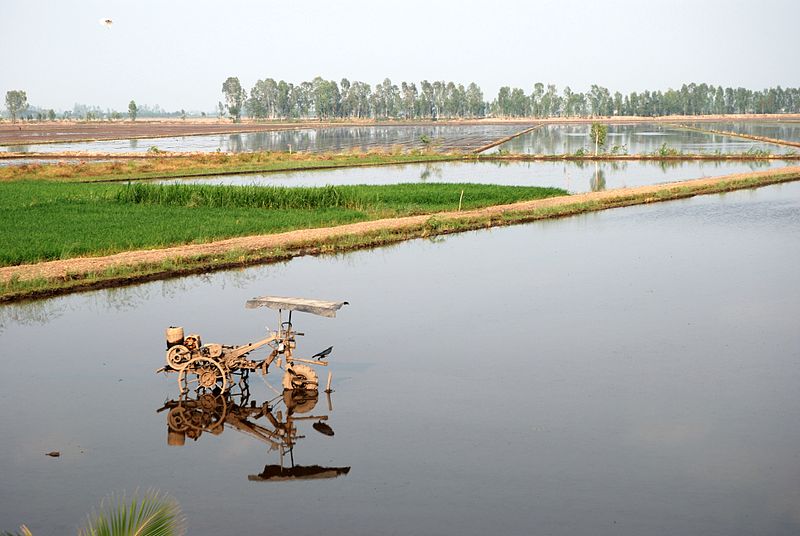
May 6, 2022 – The Mekong Delta in Viet Nam could be nearly fully submerged by the end of the century if urgent actions are not taken across the river basin. Continuing with business as usual could drown 90% of this agro-economic powerhouse that’s home to nearly 20 million people – with immense local and global impacts.
Only concerted action by the six countries in the Mekong basin and better management of water and sediments within the delta could avoid such a devastating outcome, argues an interdisciplinary research team in a commentary published last week in the journal Science. Thomas Wild, ESSIC Visiting Assistant Research Professor, is a co-author on this work.
Most of 40,000 km2 delta is less than 2m above sea level and is thus prone to climate change induced sea level rise. On top of that, actions in the delta such as over pumping of groundwater and unsustainable sand mining to construct expanding cities across Asia as well as rapid hydropower development upstream threaten the future of the most productive rice basket in Southeast Asia.
“It’s hard to fathom that a landform the size of the Netherlands and with a comparable population might disappear by the end of the century,” said lead author Professor Matt Kondolf from University of California, Berkeley. “Yet, like any river delta, the Mekong Delta can only exist if it receives a sufficient sediment supply from its upstream basin and water flows to spread that sediment across the delta surface, so that land is built at a rate that is equal or greater than global sea level rise.”
In the Mekong, water and sediment flows are increasingly endangered.
“Hungry for renewable energy, countries in the basin develop hydropower dams, which trap sediment, with little regard for system scale impacts. What little sediment reaches the lower Mekong could be mined to meet the demands of the burgeoning real estate sector in the region, which requires great amounts of sand for construction and land reclamation,” summarized co-lead author Dr Rafael Schmitt from University of Stanford.
But not all the blame can be put to upstream actions and global climate change induced sea level rise. In the delta itself, high dikes have been built to control floods and thus enable high intensity agriculture. This also prevents the fertile sediment from being deposited on the rice fields.
However, the drowning of the delta is not a fait accompli. There are steps that can be taken to allow dynamic, natural processes to help prevent the delta from further sinking and shrinking.
“The consensus amongst scientists on the scale and gravity of the threat to the Mekong delta is crystal clear, but it can be countered by ensuring the river’s waters remain muddy and murky with sediment,” said co-author Marc Goichot, WWF Asia/Pacific Freshwater Lead.
“Countries must choose a better development path for the Mekong river and region – one that is based on ambitious but feasible policies, which support a system-wide approach to energy, construction and agriculture that will build the resilience of the delta and benefit all the people and nature that depend on it. Business as usual would spell disaster for the delta,” added Goichot.
The team identify six measures that are feasible and have global precedents and would significantly increase the lifetime of the delta:
- Avoid high impact hydropower dams by replacing planned projects with wind and solar farms when possible and if not, building new dams in a strategic way that reduces their downstream impacts;
- Design and/or retrofit hydropower dams to enable better sediment passage;
- Phase out riverbed sand mining and strictly regulate all sediment mining, while reducing the need for Mekong sand through sustainable building materials and recycling;
- Re-evaluate intensive agriculture in the Mekong Delta for its sustainability;
- Maintain connectivity of delta floodplain by adapting water infrastructure; and
- Investing in natural solutions for coastal protections on a large scale along the delta’s coasts.
“Although the effectiveness of these measures, particularly if implemented in unison, is little disputed in the scientific community, major roadblocks exist for their implementation,” said Dr Schmitt.
Some of those measures would conflict with vested interests of certain actors, such as the sand mining industry and hydropower development, and some measures would require coordination among countries to account for system scale impacts and benefits of individual actions.
Countries would also need to agree that the sustenance of the Mekong delta is an important regional policy objective. In Viet Nam, where most of the delta is located, some recent policies try to counter some symptoms of a sinking delta, but there is little acknowledgement of the existential risk to the delta, nor ambition to work on truly systemic solutions.
Implementing the measures will require participation from national governments and international actors as well as new actors, including from the private sector and civil society. But together it is possible to save the delta from drowning.
“A Mekong delta that will thrive beyond the end of this century is possible – but it will require fast and concerted action in a basin that has been riddled by competition, rather than cooperation, between its riparian countries,” concluded Professor Kondolf.






